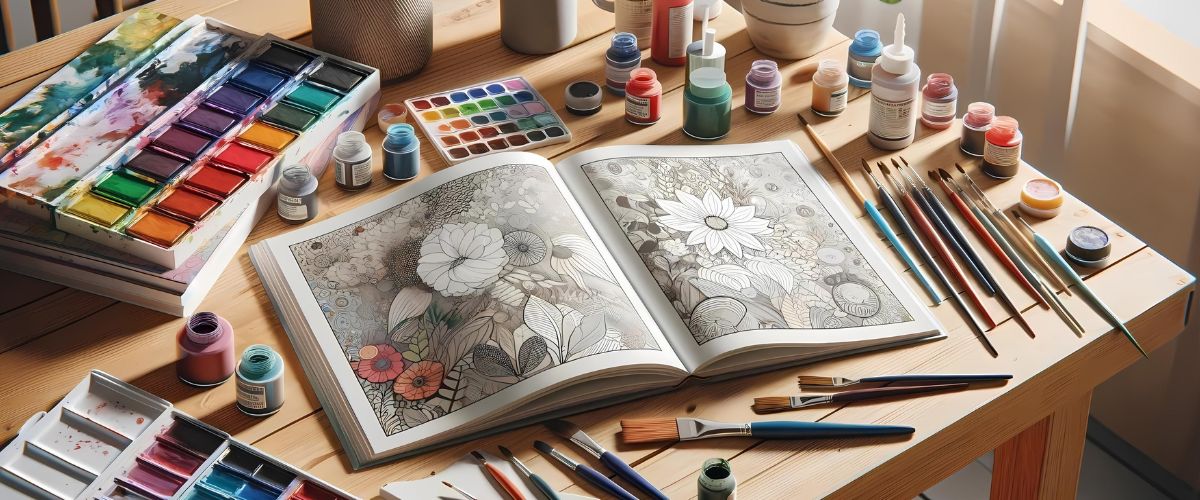Coloring books have long been a favorite pastime for children and adults alike, offering a way to relax, de-stress, and express creativity. Traditionally, coloring books are used with crayons, colored pencils, or markers. However, many people wonder: Can you paint in a coloring book? The answer is yes, but there are some important considerations to keep in mind to ensure the best results and avoid damaging the book.
Types of Paint to Use
Watercolors
Watercolors are a popular choice for painting in coloring books because they are easy to use and create beautiful, translucent effects. However, not all coloring books are suitable for watercolor painting.
Considerations:
- Paper Quality: Watercolor requires thicker, more absorbent paper to prevent warping and bleeding. Look for coloring books with high-quality, heavy paper specifically labeled as suitable for watercolor.
- Amount of Water: Use minimal water to avoid soaking the paper. Consider using watercolor pencils, which allow for more control over the water application.
Acrylic Paints
Acrylic paints are versatile and vibrant, making them another option for coloring books. They dry quickly and are less likely to bleed through the pages than watercolors.
Considerations:
- Paper Thickness: Acrylics work best on thicker paper. Ensure your coloring book can handle the weight and texture of the paint.
- Layering: Acrylics can be layered to create depth and texture. Be mindful of the amount of paint used to avoid making the pages too thick or uneven.
Gouache
Gouache is similar to watercolor but more opaque, allowing for bright, solid colors. It can be a good choice for coloring books with thicker paper.
Considerations:
- Paper Compatibility: As with watercolors and acrylics, gouache works best on thick, high-quality paper.
- Application: Apply gouache in thin layers to prevent paper from becoming too saturated or warped.
Preparing Your Coloring Book
Before you start painting, it’s essential to prepare your coloring book to minimize damage and ensure the best results.
Test a Page
Always test your chosen paint on a small, inconspicuous area or a test page (if provided) in the coloring book. This will help you understand how the paper reacts to the paint and how much water or paint to use.
Protecting Other Pages
To prevent paint from bleeding through and damaging other pages, place a piece of thick cardboard or a few sheets of scrap paper behind the page you are working on. This will absorb any excess paint and keep the rest of the book clean.
Tape Down the Edges
If the coloring book’s paper is prone to warping, you can tape down the edges of the page with painter’s tape or masking tape. This helps keep the paper flat as you paint and prevents it from curling up.
Painting Techniques
Dry Brush Technique
Using a dry brush technique minimizes the amount of water on the paper, reducing the risk of warping. Load your brush with paint and remove excess water before applying it to the paper. This technique is particularly useful for acrylics and gouache.
Light Layers
Apply paint in light layers, allowing each layer to dry before adding another. This technique helps prevent the paper from becoming oversaturated and warping. It also allows for better control over color intensity and blending.
Mixing Mediums
Consider mixing different mediums to achieve unique effects. For example, you can use watercolors for background washes and acrylics or gouache for detailed work. This approach allows you to utilize the strengths of each medium.
Choosing the Right Coloring Book
Not all coloring books are created equal when it comes to painting. Here are some features to look for in a coloring book suitable for painting:
Paper Thickness
Look for coloring books with thick, high-quality paper. Paper weight is often measured in pounds (lb) or grams per square meter (gsm). Aim for paper that is at least 120 lb (190 gsm) or higher for the best results with paint.
Single-Sided Pages
Coloring books with single-sided pages (one illustration per sheet) are preferable for painting. This ensures that you won’t ruin a picture on the back of the page you’re painting on. Some coloring books even have perforated pages, allowing you to remove and work on them individually.
Specific Labels
Some coloring books are specifically labeled as suitable for various painting mediums, such as watercolors or acrylics. These books typically feature thicker paper designed to handle wet media.
Conclusion
In conclusion, you can indeed paint in a coloring book, but it requires careful consideration of the type of paint, paper quality, and painting techniques. By choosing the right materials and preparing your coloring book properly, you can enjoy the process of painting and create beautiful, vibrant artworks in your coloring book. Whether you use watercolors, acrylics, or gouache, painting in a coloring book can be a delightful and rewarding experience that adds a new dimension to this beloved pastime.





